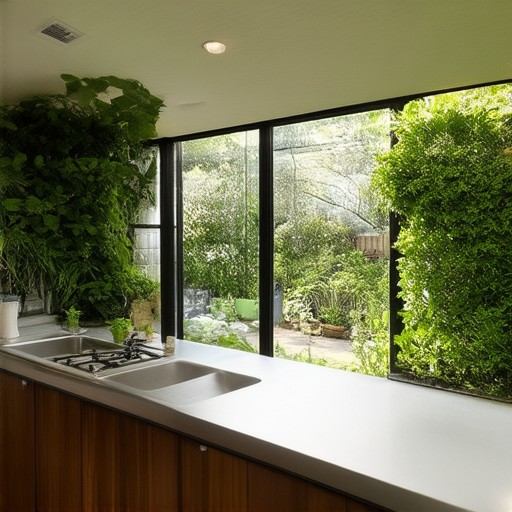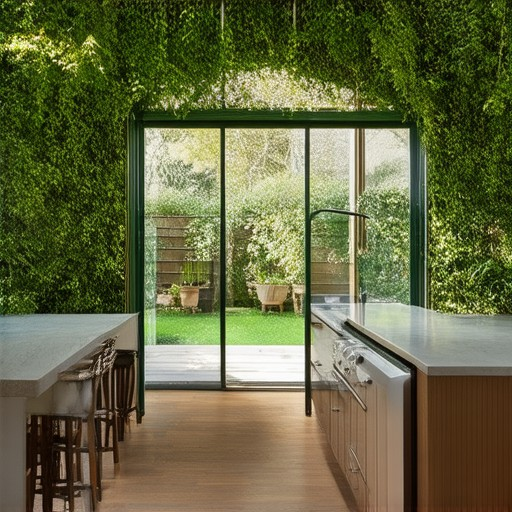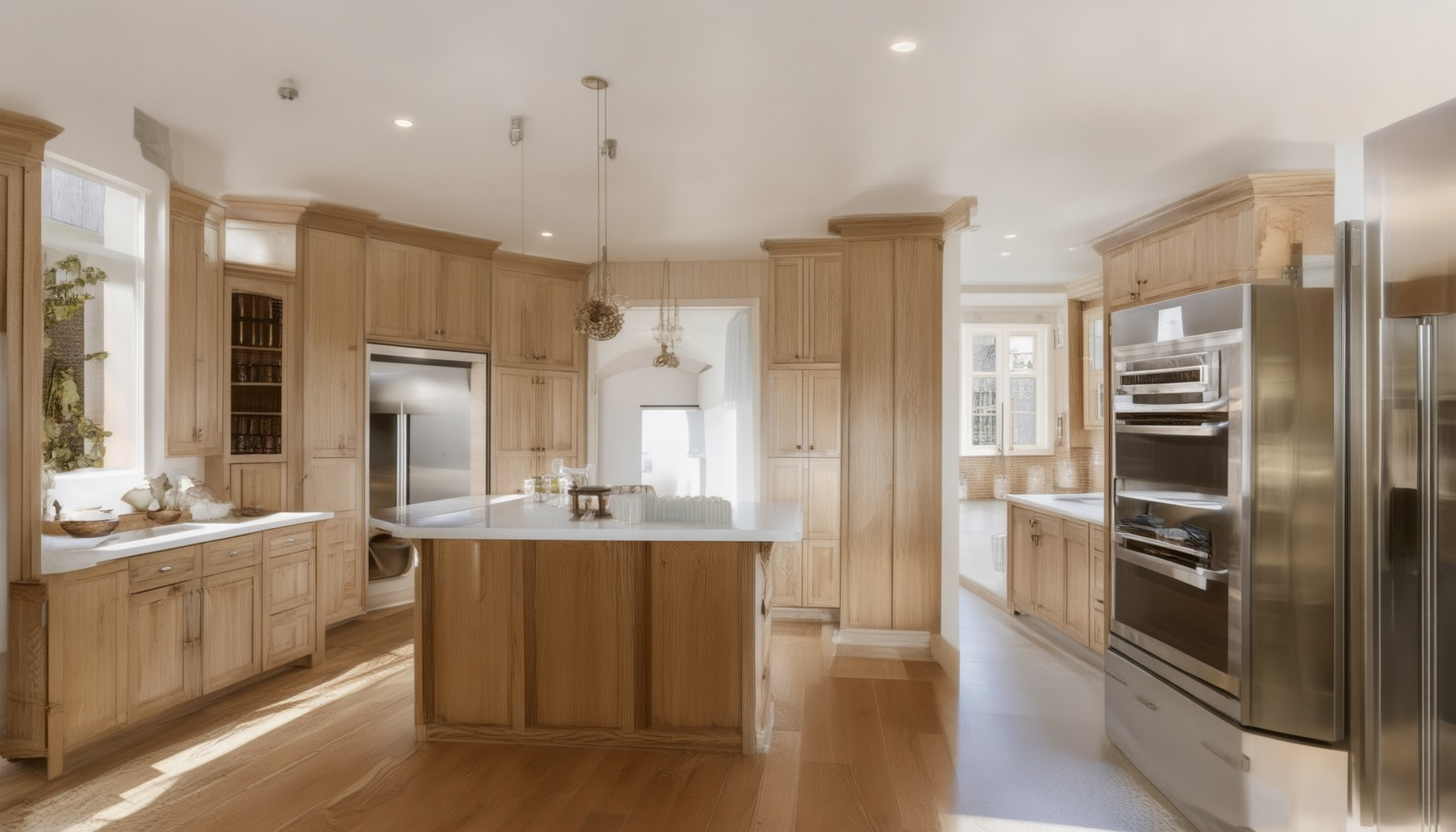Are you looking to transform your kitchen into a space that’s both functional and environmentally conscious? Choosing eco-friendly kitchen designs isn’t just a trend—it’s a responsible choice that contributes to a healthier planet. This guide explores sustainable materials, energy-efficient appliances, and innovative tools that help minimize your kitchen’s environmental footprint. By integrating eco-friendly products and making thoughtful design choices, you can create a kitchen that aligns with your values while enhancing daily life. Join us as we delve into the world of eco-friendly kitchen design, where every decision matters.
To transform your kitchen into an eco-friendly space, consider the following organized approach:
1. Assess Current Setup and Prioritize
- Materials: Begin by evaluating your current countertops, cabinetry, and flooring. Replace granite or marble with sustainable options like recycled concrete, bamboo, or composite materials. Consider FSC-certified wood or reclaimed wood for cabinetry and low-VOC finishes to improve air quality.
- Appliances: Upgrade to ENERGY STAR-rated appliances, including refrigerators with smart features and induction cooktops. Check for certifications like ENERGY STAR and FSC to ensure eco-friendliness.
2. Budget Considerations
- Cost-Effective Upgrades: Start with LED lighting and energy-efficient dishwashers, which offer significant savings. Gradually replace cleaning products with vinegar and baking soda, and integrate microfiber cloths as existing towels wear out.
3. Layout and Design
- Open Layout: If feasible, opt for an open kitchen design to enhance airflow, especially with materials like bamboo or reclaimed wood. Ensure seamless integration of eco-friendly elements without compromising functionality.
4. Waste Management and Recycling
- Compost Bin: Place a small bin near the sink for kitchen scraps to create nutrient-rich soil.
- Recycling Station: Set up labeled bins for paper, glass, and metal in a designated zone to encourage family participation.
5. Cleaning Practices
- Natural Cleaners: Transition to vinegar and baking soda for cleaning, starting with one product at a time. Replace traditional towels with microfiber cloths for reduced water and detergent use.
6. Long-Term Considerations
- Durable Materials: Invest in high-quality, durable materials to minimize waste and replacements.
- Certifications: Look for reputable certifications like FSC, ENERGY STAR, and Greenguard to ensure eco-friendly practices throughout the supply chain.
7. Professional Consultation
- Eco-Friendly Designer: Consider consulting with a professional designer specializing in sustainable kitchens for tailored advice and local material recommendations.
By systematically addressing each area, you can create a kitchen that is both stylish and environmentally responsible. Start with impactful changes like countertops and appliances, then expand to layout and cleaning practices, ensuring each step aligns with your lifestyle and budget.

Best Practices for Creating an Eco-Friendly Kitchen Design
Creating an eco-friendly kitchen design involves thoughtful planning and consideration of sustainable materials, energy-efficient appliances, and environmentally friendly practices. Here are some expert-recommended best practices to help you achieve a green kitchen space:
- Sustainable Material Selection
- Bamboo: A rapidly renewable resource ideal for flooring and countertops.
- Recycled Wood: Available in various forms, perfect for cabinetry and countertops.
- Cement Countertops: Lowers carbon footprint compared to granite or marble.
- Eco-Friendly Paint: Water-based paints with low volatile organic compounds (VOCs).
- Energy Efficiency
- Energy Star Appliances : Save energy and reduce utility bills while minimizing environmental impact.
- Smart Home Automation: Use programmable thermostats and timers to optimize cooking temperatures and ventilation.
- LED Lighting: Reduces energy consumption significantly compared to incandescent bulbs.
- Water Conservation
- Low-Flow Fixtures: Faucets and showerheads designed to conserve water.
- Greywater Systems: Recycle water from sinks and washing machines for non-drinking purposes.
- Drip Irrigation: Efficient watering system for plants, reducing outdoor water usage.
- Waste Reduction
- Composting: Create a compost bin or pile near your kitchen for food scraps and yard waste.
- Recycling Centers: Install dedicated bins for recyclables to encourage proper disposal.
- Minimal Packaging Use: Choose bulk goods or refillable containers to reduce plastic waste.
- Natural Cleaning Products
- Baking Soda: Effective cleaner for surfaces and odors.
- Vinegar Solutions: Safe for most surfaces and effective against bacteria.
- Essential Oils: Add a few drops to water for a natural disinfectant.
- Eco-Certified Products
- FSC Certified Woods: Forest Stewardship Council certification ensures sustainable forestry practices.
- Green Seal Products: Independently certified for health and environmental safety.
- LEED Certification: Look for LEED Gold or Platinum designation for high sustainability standards.
By incorporating these eco-friendly practices into your kitchen design, you can create a sustainable space that reduces your environmental footprint while enhancing functionality and aesthetics. For more tips and resources, explore our Kitchen Design Tips and Sustainable Living Guides .
Creating an Eco-Friendly Kitchen Design
To design an eco-friendly kitchen, consider the following steps:
- Use Recycled Materials: Opt for countertops made from recycled materials like recycled glass or concrete. These options reduce the demand for raw resources and can be just as durable as traditional materials.
- Install Low-Flow Fixtures: Replace regular faucets and showerheads with low-flow models. These conserve water and reduce utility bills.
- Choose Energy-Efficient Appliances: Select Energy Star-certified appliances, such as refrigerators, ovens, and dishwashers, to minimize energy consumption.
- Paint with Non-Toxic Paint: Use low-VOC or no-VOC paint for walls and cabinets to reduce exposure to harmful chemicals.
- Opt for Sustainable Lighting: Replace traditional bulbs with LED lights, which are more energy-efficient and long-lasting.
- Use Sustainable Flooring: Consider eco-friendly materials like bamboo or cork, which are renewable resources and provide insulation benefits.
- Incorporate Recycled Cabinets: Choose cabinets made from reclaimed wood to give your kitchen a unique look while reducing waste.
- Add Recycling Stations: Install a pull-out trash bin and a recycling station near your kitchen to encourage proper waste separation.
- Include Compost Bins: Place compost bins near the kitchen to manage food waste effectively and contribute to your garden.
- Integrate Green Plants: Add plants like herbs or succulents to your kitchen for a fresh look and cleaner air. Choose low-maintenance varieties for busy lifestyles.
- Practice Energy-Saving Habits: Use energy-saving habits such as turning off appliances when not in use and utilizing timers to remind you to unplug devices.
- Conserve Water: Install a low-flow faucet and consider a rain shower head to reduce water usage during showers.
- Store Bulk Goods in Reusable Containers: Use airtight containers or cloth bags for storing grains, nuts, and other dry goods to minimize plastic waste.
- Plan Efficient Appliance Placement: Arrange cooking appliances on the opposite side of the sink to encourage shorter rinse times and conserve water.
- Design for Natural Light: Position your kitchen near windows to maximize natural light, reducing the need for artificial lighting during the day.
- Choose Eco-Friendly Color Palettes: Select color schemes that are environmentally friendly, such as natural tones that align with sustainable living principles.
- Invest in Durable, High-Quality Materials: While initial costs may be higher, investing in long-lasting materials ensures less frequent replacements and a lower environmental footprint over time.
- Foster Family Involvement: Involve everyone in the household in eco-friendly practices, such as recycling and turning off lights when leaving the room.
By following these steps, you can create a kitchen that is both functional and environmentally conscious, contributing positively to the planet while enjoying a beautiful and comfortable space.

Eco-Friendly Kitchen Products and Design Choices
To reduce your environmental impact in the kitchen, consider adopting sustainable products and thoughtful design choices that minimize waste and resource consumption. Here’s a comprehensive guide:
- Reusable Products:
- Cloth napkins instead of paper ones.
- Stainless steel or bamboo utensils over disposables.
- Water bottles and food containers made from sustainable materials.
- Compostable kitchen scraps collection.
- Sustainable Design Choices:
- Install energy-efficient lighting, such as LED under-cabinet lights.
- Use low-flow faucets and water-saving fixtures.
- Consider countertops made from recycled materials or sustainably harvested wood.
- Opt for cabinetry with drawers for better storage efficiency.
- Additional Tips:
- Repurpose food scraps for composting or garden use.
- Buy in bulk to reduce plastic packaging waste.
- Choose locally-sourced or organic ingredients whenever possible.
By incorporating these eco-friendly products and design strategies into your kitchen, you can significantly reduce your environmental footprint while creating a more sustainable living space.
For more insights, explore our Sustainable Kitchen Design Guide and learn about Top Eco-Friendly Products .

Creating an Eco-Friendly Kitchen Design
Eco-friendly kitchens are not just a trend—they’re a responsible choice for the planet and your health. By thoughtfully selecting materials, appliances, and layouts, you can transform your kitchen into a sustainable hub that minimizes its environmental impact while maximizing functionality.
Sustainable Materials
- Countertops: Opt for recycled concrete, bamboo, or composite materials made from renewable resources. These options are durable and have a lower carbon footprint compared to traditional granite or marble.
- Cabinetry: Choose cabinets made from FSC-certified wood or reclaimed wood. Look for companies that offer low-VOC finishes to reduce chemical emissions.
- Flooring: Bamboo, cork, or linoleum are excellent eco-friendly flooring options. They are renewable, biodegradable, and easy to clean.
- Wall Coverings: Consider low-VOC paint or wallpaper made from natural fibers like grasscloth or hemp.
Energy-Efficient Appliances
- Refrigerator: Select ENERGY STAR-rated models to reduce energy consumption. Some models even have features that monitor food freshness and adjust storage temperatures optimally.
- Oven and Stove: Choose induction cooktops, which use less energy than gas or electric stoves. Electric kettles and slow cookers are also energy-efficient alternatives.
- Dishwashers: Install aENERGY STAR-rated dishwasher with a sensor that adjusts the cycle length based on the number of dishes loaded.
Layout and Functionality
- Open Layout: Create a spacious kitchen with an open design to enhance airflow and reduce the need for artificial ventilation.
- Task Lighting: Use LED under-cabinet lighting or solar-powered lights to minimize energy use while providing ample illumination.
- Appliance Placement: Position energy-hungry appliances like the refrigerator near outlets to reduce cord length and potential tripping hazards.
Waste Management
- Compost Bin: Keep a small compost bin in your kitchen for scraps of food. This reduces landfill waste and creates nutrient-rich soil for your garden.
- Recycling Zone: Designate a corner of your kitchen for recycling paper, glass, and metal. Use labeled bins to make it easy for family members to participate.
Healthy Cleaning Practices
- Non-Toxic Cleaners: Use vinegar and baking soda for cleaning tasks. These natural ingredients are safe for the environment and your health.
- Microfiber Cloths: Replace traditional towels with microfiber cloths to reduce the amount of water and detergent used during cleaning.
Long-Term Considerations
- Durable Materials: Invest in high-quality, durable materials that will last longer, reducing the frequency of replacements and waste.
- Certifications: Look for products with certifications like FSC, ENERGY STAR, or Greenguard to ensure they meet environmental standards.
By integrating these eco-friendly elements into your kitchen design, you’ll not only create a healthier living space but also contribute positively to the environment. Start with small changes and gradually incorporate more sustainable practices to see the biggest impact.
For more tips and resources on creating an eco-friendly kitchen, visit Peck and Gartner today!
Effective Ways to Integrate Eco-Friendly Elements into Your Kitchen Design
Transforming your kitchen into an eco-friendly space involves thoughtful choices in materials, appliances, and design. Here are some proven strategies to achieve this:
- Sustainable Countertops:
- Bamboo: A rapidly renewable resource ideal for countertops, offering durability and a natural aesthetic.
- Recycled Concrete: Made from demolished concrete, it reduces waste and has a lower carbon footprint.
- Corian: A solid surface option made from acrylics and polyester, known for its durability and sustainability.
- Eco-Friendly Cabinetry:
- Reclaimed Wood: Repurpose old materials to minimize environmental impact while adding charm to your kitchen.
- Low-VOC Finishes: Opt for water-based sealants and paints to improve indoor air quality.
- Energy-Efficient Lighting:
- LED Under-Cabinet Lighting: Reduces energy consumption and heat production, making it safer for countertops.
- Sustainable Flooring:
- Linoleum: A natural, biodegradable material that’s easy to install and maintain.
- Cork: Provides insulation and is derived from renewable resources, perfect for kitchen flooring.
- Recycled Vinyl: Made from post-consumer plastic, it’s a durable and eco-friendly alternative.
- Eco-Conscious Appliances:
- Energy Star-Rated Appliances: Designed to save energy and reduce environmental impact.
- Smart Appliances: Use technology to optimize energy usage, such as dishwashers with delay start functions.
- Water Conservation Features:
- Low-Flow Faucets: Reduce water usage during tasks like washing dishes or cooking.
- Water-Saving Showerheads: Perfect for hands-on tasks in the kitchen.
- Greywater Systems: Recycle wastewater for non-drinking purposes, reducing freshwater demand.
- Recycled Decor and Accessories:
- Pallets for Backsplashes: Transform discarded materials into decorative elements.
- Repurposed Materials: Use old bricks or tiles creatively to add texture and character.
- Functional Layout and Design:
- Open Layout: Enhances airflow, which is crucial for materials like bamboo or reclaimed wood.
- Seamless Integration: Combine eco-friendly elements without compromising on functionality.
- Local Sourcing and Professional Consultation:
- SOURCE LOCALLY: Minimize transportation emissions by purchasing materials and appliances from local suppliers.
- Consult a Sustainable Designer: Tailor your kitchen design to incorporate eco-friendly elements effectively.
By thoughtfully integrating these elements, you can create a kitchen that’s both stylish and environmentally responsible. Start with one area and expand as your budget allows, focusing on materials that align with your lifestyle and design preferences.

What Key Elements Are Important for Creating an Eco-Friendly Kitchen Design?
- Sustainable Materials: Use reclaimed wood, recycled metal, and low-VOC paints to minimize environmental impact. Opt for eco-friendly finishes and avoid harmful chemicals.
- Energy Efficiency: Install Energy Star-rated appliances, LED lighting, and programmable thermostats to reduce energy consumption and lower utility bills.
- Water Conservation: Incorporate low-flow fixtures, dual-flush toilets, and water-saving showerheads to decrease water usage.
- Recycling and Composting: Set up recycling stations and compost bins to manage waste effectively. Consider a pull-out trash bin for easy access.
- Air Quality Improvement: Add houseplants like spider plants or succulents to purify the air, and use air filters to further enhance indoor air quality.
- Renewable Resources: Source locally-sourced or sustainably-harvested materials whenever possible to support eco-friendly practices and reduce carbon footprint.
- Smart Design Layout: Create an open layout to maximize natural light and cross-ventilation, reducing the need for artificial lighting and AC usage.
- Eco-Friendly Cleaning Products: Use biodegradable detergents, natural cleaning solutions, and microfiber cloths to maintain a clean kitchen without harmful chemicals.
- Waste Reduction Systems: Implement a small kitchen garden or vertical farm to grow herbs and vegetables, reducing the need for store-bought produce.
For more tips and inspiration, explore our home improvement guides and learn how to create a sustainable kitchen space tailored to your lifestyle.
Conclusion: An eco-friendly kitchen design isn’t just about aesthetics—it’s about making mindful choices that benefit the environment. By focusing on sustainable materials, energy efficiency, and smart design, you can create a kitchen that’s as good for the planet as it is for your family.





0 Comments